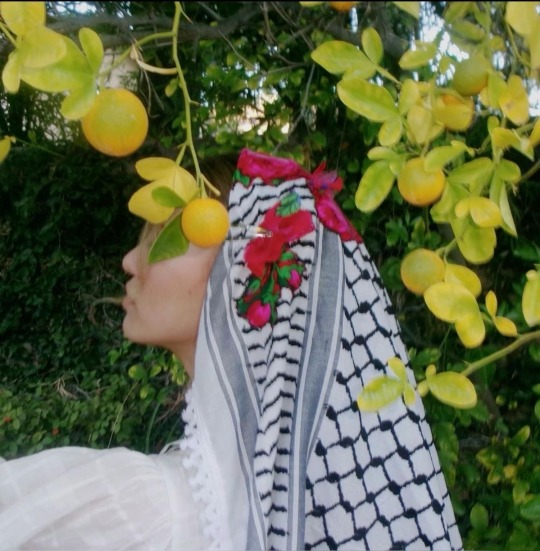#levantine
Explore tagged Tumblr posts
Text

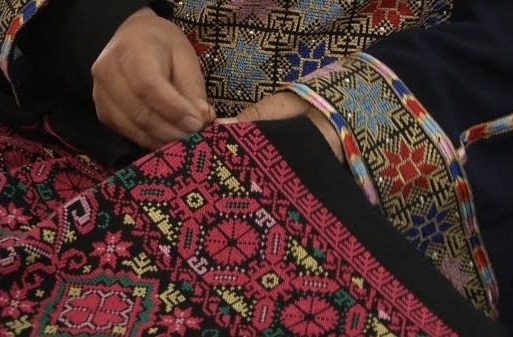

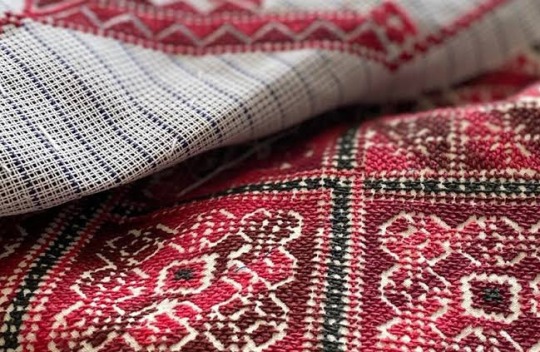
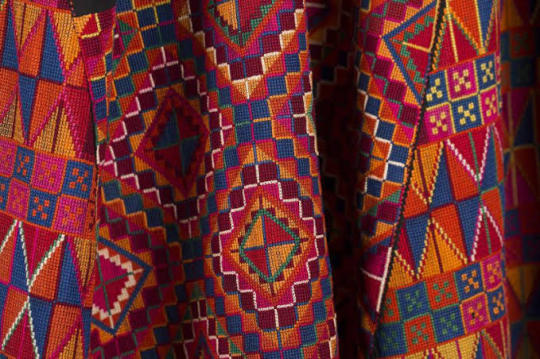

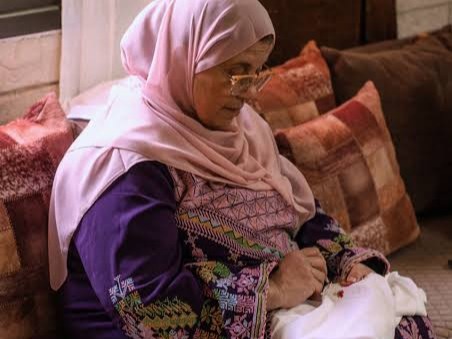

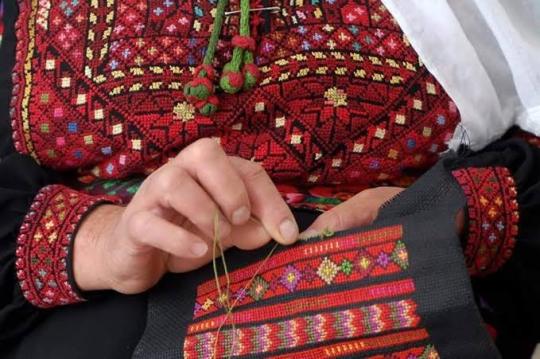

Tatreez (Arabic: تطريز) is a type of traditional Palestinian embroidery. Tatreez uses traditional cross-stitch embroidery and is practiced largely among women. The craft was originally practiced in rural areas of Palestine, but is now common across the Palestinian diaspora. Historically, each village in Palestine had their own tatreez patterns. The landscape was a major source of inspiration for the patterns and motifs, which speaks to the variation in style that was common to see among all of the different tatreez expressions that were particular to each Palestinian village.
After the violent displacement and dispossession of Palestinians in 1948, people were living together in refugee camps. The different styles of tatreez became less distinct and have continued to evolve with the diaspora. Following 1948, tatreez evolved to reflect the experiences of Palestinians. Palestinian women began to incorporate the Palestinian flag and its colors into their tatreez as a means of resistance to the occupation of Palestine. Consequently, tatreez became an expression of the identity, heritage and resistance of Palestinian women and their dedication to preserve their ancient culture.
1 / 2 / 3 / 4 / 5 / 6 / 7 / 8 / 9 / 10 / 11 | textile series
#textiles#ots#tatreez#palestine#palestinian art#palestinian culture#free palestine#embroidery#textile art#middle east#levant#levantine#fashion
14K notes
·
View notes
Text
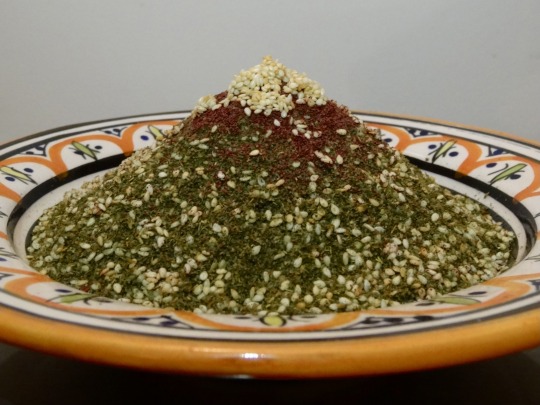
[ID: A decorative orange ceramic plate with a pyramid of green herbs and sesame seeds, topped with deep red sumac and more sesame seeds. End ID]
زعتر فلسطيني / Za'tar falastinia (Palestinian spice blend)
Za'tar (زَعْتَر; also transliterated "za'atar," "zaatar" and "zatar") is the name of a family of culinary herbs; it is also the name of a group of spice blends made by mixing these herbs with varying amounts of olive oil, sumac, salt, roasted sesame seeds, and other spices. Palestinian versions of za'tar often include caraway, aniseed, and roasted wheat alongside generous portions of sumac and sesame seeds. The resulting blend is bold, zesty, and aromatic, with a hint of floral sourness from the sumac, and notes of licorice and anise.
Za'tar is considered by Palestinians to have particular national, political, and personal importance, and exists as a symbol of both Israeli oppression and Palestinian home-making and resistance. Its major components, olive oil and wild thyme, are targeted by the settler state in large part due to their importance to ecology, identity, and trade in Palestine—settlers burn and raze Palestinian farmers' olive trees by the thousands each year. A 1977 Israeli law forbade the harvesting of wild herbs within its claimed borders, with violators of the law risking fines and confiscation, injury, and even death from shootings or land mines; in 2006, za'tar was further restricted, such that even its possession in the West Bank was met with confiscation and fines.
Despite the blanket ban on harvesting wild herbs (none of which are endangered), Arabs are the only ones to be charged and fined for the crime. Samir Naamnih calls the ban an attempt to "starve us out," given that foraging is a major source of food for many Palestinians, and that picking and selling herbs is often the sole form of income for impoverished families. Meanwhile, Israeli farmers have domesticated and farmed za'tar on expropriated Palestinian land, selling it (both the herb and the spice mixture) back to Palestinians, and later marketing it abroad as an "Israeli" blend; they thus profit from the ban on wild harvesting of the herb. This farming model, as well as the double standard regarding harvesting, refer back to an idea that Arabs are a primitive people unfit to own the land, because they did not cultivate or develop it as the settlers did (i.e., did not attempt to recreate a European landscape or European models of agriculture); colonizing and settling the land are cast as justified, and even righteous.
The importance of the ban on foraging goes beyond the economic. Raya Ziada, founder of an acroecology nonprofit based in Ramallah, noted in 2019 that "taking away access to [wild herbs] doesn't just debilitate our economy and compromise what we eat. It's symbolic." Za'tar serves variously as a symbol of Palestinians' connection to the land and to nature; of Israeli colonial dispossession and theft; of the Palestinian home ("It’s a sign of a Palestinian home that has za’tar in it"); and of resistance to the colonial regime, as many Palestinians have continued to forage herbs such as za'tar and akkoub in the decades since the 1977 ban. Resistance to oppression will continue as long as there is oppression.
Palestine Action has called for bail fund donations to aid in their storming, occupying, shutting down, and dismantling of factories and offices owned by Israeli arms manufacturer Elbit Systems. Also contact your representatives in the USA, UK, and Canada.
Ingredients:
Za'tar (Origanum syriacum), 250g once dried (about 4 cups packed)
250g (1 2/3 cup) sesame seeds
170g (3/4 cup) Levantine sumac berries, or ground sumac (Rhus coriaria)
100g (1/2 cup) wheat berries (optional)
2 Tbsp olive oil
1 Tbsp aniseed (optional)
1/2 Tbsp caraway seeds (optional)
Levantine wild thyme (also known as Bible hyssop, Syrian oregano, and Lebanese oregano) may be purchased dried online. You may also be able to find some dried at a halal grocery store, where it will be labelled "زعتر" (za'tar) and "thym," "thyme," or "oregano." Check to make sure that what you're buying is just the herb and not the prepared mixture, which is also called "زعتر." Also ensure that what you're buying is not a product of Israel.
If you don't have access to Levantine thyme, Greek or Turkish oregano are good substitutes.
Wheat berries are the wheat kernel that is ground to produce flour. They may be available sold as "wheat berries" at a speciality health foods store. They may be omitted, or replaced with pre-ground whole wheat flour.
Instructions:
1. Harvest wild thyme and remove the stems from the leaves. Wash the leaves in a large bowl of water and pat dry; leave in a single layer in the sun for four days or so, until brittle. Skip this step if using pre-dried herbs.
2. Crumble leaves by rubbing them between the palms of your hands until they are very fine. Pass through a sieve or flour sifter into a large bowl, re-crumbling any leaves that are too coarse to get through.
Crumbling between the hands is an older method. You may also use a blender or food processor to grind the leaves.
3. Mix the sifted thyme with a drizzle of olive oil and work it between your hands until incorporated.
4. Briefly toast sumac berries, caraway seeds, and aniseed in a dry skillet over medium heat, then grind them to a fine powder in a mortar and pestle or a spice mill.
5. Toast sesame seeds in a dry skillet over medium heat, stirring constantly, until deeply golden brown.
6. (Optional) In a dry skillet on medium-low, toast wheat berries, stirring constantly, until they are deeply golden brown. Grind to a fine powder in a spice mill. If using ground flour, toast on low, stirring constantly, until browned.

Some people in the Levant bring their wheat to a local mill to be ground after toasting, as it produces a finer and more consistent texture.
7. Mix all ingredients together and work between your hands to incorporate.
Store za'tar in an airtight jar at room temperature. Mix with olive oil and use as a dipping sauce with bread.
2K notes
·
View notes
Text

Colorised photo of three women milling grain in Jerusalem, undated
#photography#photogravure#women#grain#jerusalem#palestine#israel#middle east#west asia#levant#levantine#history
26 notes
·
View notes
Text
Syrian courtyard
Old Damascene details.

#syria#سوريا syria#middle east#west asia#culture#middle eastern#west asian#aesthetic#arab#levantine#fountain
11 notes
·
View notes
Text
For years I have only even lurked on social media. Reddit, Instagram, Facebook and TickTok. I never had desires beyond watching, though the ADHD rejection sensitivity also came into play. Imagining someone arguing with me, mocking me, or simply recognizing my presence would set off my fight or flight response.
Six months ago I met a Syrian man, Ahmed, who was broadcasting a TikTok live. He lived in a camp for people who had lost their homes during the war and spent his days on TikTok giving out food to the hungry children of the camp, while soliciting donations for future meals.
Initially believing this to be a scam, I took to Google, only to find a BBC article discussing this exact situation: Syrians displaced from the homes during the war, no humanitarian aid, no employment opportunities, but working with a TikTok middle man who gave them phones to broadcast from. TikTok supported this unofficial program because, for every monetary gift the creator received, TikTok kept 70% of the donation, releasing only 30% to the account holder. Great money making deal for TikTok!
Now, I can feel you rolling your eyes in disbelief at my naivety. If I heard someone else telling this story, I’d react the same way. Over time, Ahmed and I became good friends. We speak every day, share our family stories, check in on each other, and learn about the cultural differences in our lives. After 6 months of these conversations, speaking with his family and fact checking their experiences in the war (city, dates of displacement, locating their former home on Google maps) I trust these people completely.
These people have fully accepted me into their life, and I consider them true family. Let me tell you who they are…
Ahmed is 29 years old. He is who I first saw on the broadcast. He has a wife and 2 children. He lives in a large tent, hot in the summer, cold in the winter. They have a small portable gas stove, a wood stove during the winter (which burns hazelnut shells as fuel) and frequently cook their meals outside over open fire, as this is a cheaper alternative to gas for the stove.
He lives next to his younger brother, Bassam, who is also married and expecting a baby boy soon. They all have the same tent setup, each with their own wood stove, but sharing the cooking supplies and other living essentials.
Ahmed and Bassam both live next to their parents, 2 teenage brothers and 1 teenage sister. They also have 3 sisters who have married and live in other camps with their husbands’ family.
This extended family has all lived in this camp for around 8 years now. They fled their home in the midst of a battle between the Syrian regime and rebel militias who each wanted to control the area, integral to the success of either side. They saw nightmarish scenes as they ran; bodies of the dead and injured all around them. They took nothing with them as they ran. Ahmed says, “We escaped with only our souls.”
For 6 months I’ve been sending Ahmed and his family money every 2 weeks, through Western Union, since TikTok takes an excessive amount. Western Union and PayPal don‘t allow direct transfer to anyone in Syria due to the US sanctions, however there is a community of generous people in Turkey who will pickup the transferred money and meet with Ahmed to give him cash. And yes, I have confirmed that he receives the money every time.
Ahmed used to make some relatively decent money on his TikTok videos, however overtime the algorithm changed. It started banning his accounts, or simply hiding them from viewers. Donations dwindled down to nearly nothing and he can no longer feed the children of the camp, or his own family.
The money I send provides breathing room for survival, though not to a level of comfort. Food is meager, usually a breakfast off bread, olive oil and za’atar. Lunch is a larger meal of soup and bread, and dinner is sometimes, often, skipped. Meat of any kind is a rare treat, usually lamb or chicken. Eggplant, tomatoes, bread, fava beans, lentils, rice, pickles, and fresh mild green peppers.
So, welcome to my family! I hope you’ll stick around to hear more about them, their lives, and the challenges they face in a war ravaged country.
8 notes
·
View notes
Text

Dinner tonight:
Chicken Shawarma with yoghurt sauce and Mediterranean rice
16 notes
·
View notes
Note
hi there! may I ask if you could share some examples of filler words/phrases in Levantine dialects (like 'well', 'you know', 'I mean' etc are used in English)? thanks so much; your blog is so helpful!
Hi anon!
Thank you for your kind words! I'm happy you find my blog to be helpful!
Alright, I'll tell you a list of filler words and interjections from the top of my head :
خَلاص (ẖalās) or alternatively خَلَص ẖalas
This one is very popular filler. I know many non-Arabic speakers who incorporated this word to their daily vocabulary. Literally it means that's it or it's enough, it's used as a filler.
خَلَاص قٌلْتِلُّه / ẖalas oltello / that's it I told him مَهُو خَلاص عرفنَا / ẖalas ʿrefnā / ummm... that's it we know.
مَا هُو mā hou ( alternatively pronounced as مَهُو ma hoo)
It's similar to خلاص, it means "that is", I personally use it a lot especially when there's a long justification or a story to be told.
يَعْنِي yaʿnī
This means "it means" but it's used like the fillers "like" and "that is" are used in English or even "ummm". I think this one has the best potential to be a versitile filler. For example : يَعْنِي... مَا بعَرِف شُو قَصدُه / yaʿnī .....mā baʿref šū 'asdo / um.... I don't know what he meant كَان قَصدي- يَعْنِي- عَن المَدْرَسِة / kān ʾasdī -yaʿnī- ʿan el madraseh / I meant... uhhh ... about school
أصْلًا aṣlan
This means "originally" but can be used as a filler especially when someone is being defensive. أصْلًا مَا بدي/ aṣlan mā beddi / it means "I didn't even want it" أَصْلَا عَاديَ / aṣlan ʿādi / when said angrily it means something within the line of " I didn't even care" or "hmph! whatever"
يوووو عاد Yō ʿād or ييييي عَاد Yeeee ʿād
Ok this one is hard to translate so I'll give the context. When saying one of these two, or sometimes خَلاص عاد ẖalās ʿād, you're expressing you're anger at something annoying that is really repetitive. Like someone is nagging at something again or a problem keeps re-occurring. Basically you're being impatient and expressing how annoyed your are. عَاد literally means "he came back" or he returned in MSA, but it's used as an interjection or filler in dialects
ييييييي Yeeee / يييي عَلينا ʿaleina or Yeee
These are used like "oh no" or "oh my goodness" For example if someone remembers that you remember that the cake was still in the oven even after they left the house, they will probably yell "yeeeee" after face palming
أوف off
this is used when you hear something that exceeds your expectations. For example you anticipated that the dress was for 40 $ but it's for 400$, you would say "offf" and then walk away. Sometimes "off" is also used to express distaste or being bored
#dialects#levantine#urban palestinian dialect#levantine dialect#there is an interjection that I really like in Syrian dialect where they say “laaaa wloooo”#my friend used to say it all the time#she used to say it when I'm thanking her like “oh don't say that gurl we good”#I don't know if this counts as an interjection or filler though#plus I wasn't sure if it had other uses I wasn't aware of
19 notes
·
View notes
Text

I can only respond as an Ashkenazi, I don’t know how everyone else feels, but I disagree. I am a Zionist. I feel a strong cultural and religious connection to the homeland. I even plan on permanently living in Israel when I’m older. But I’m also European. My great-grandparents were born in Poland and Italy, and I feel a connection to those places. Additionally, I feel a strong connection to both Hebrew and Yiddish, and even as a Zionist I don’t think Yiddish should be “phased out.” It’s a language of our European history and I like that.
5 notes
·
View notes
Text

Pendant Frame of Goddess on Horseback
Levantine, 15th-13th century BCE
Only the base plate and frame of this pendant survive. Traces of white and light-blue inlays provide clues to its original appearance. The figure represents the Near Eastern goddess of war and love, known as Ishtar in Mesopotamia and Astarte in Syria and Egypt. The goddess wears an Egyptian crown and brandishes a spear above her head. She appears on a horse, which had only recently begun to be used in warfare.
24 notes
·
View notes
Text

"i'm from beirut"
5 notes
·
View notes
Text
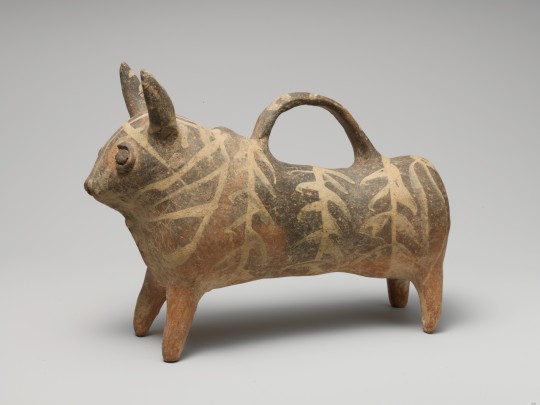
Terracotta bull vase
Cypriot ca. 1450–1200 BCE
On view at The Met Fifth Avenue in Gallery 171
The quality of Base Ring Ware deteriorated in the Late Cypriot II period but new shapes were introduced, especially vessels in the form of animals, of which the bull was most common. - The MET
Base Ring Ware is one of the most distinctive and important archaeological hallmarks of the Late Bronze Age in Cyprus. The technical ceramic standards achieved in this ware coupled with its wide distribution provided a valuable opportunity to study the technological skills of the ancient Cypriot craftsmen as well as to assess the degree of sophistication of their knowledge, and ability to manipulate the local ceramic material resources. - Levantine Ceramics Project
[Bull: Bronze Age civilization of Crete (about 3000 BC to 1100 BC) remarkable for its extended trade throughout the Levant and beyond]
https://www.metmuseum.org/art/collection/search/240414
https://www.levantineceramics.org/wares/804-late-cypriot-base-ring-wares
15 notes
·
View notes
Text

[ID: A pyramid of crystalline snow topped with deep orange syrup on a bright blue plate. End ID]
بقسمة / Buqsuma (Palestinian snow dessert)
بُقْسُمَة ("buqsuma"), or بوظة الشتاء ("būẓa shitā'", "winter ice cream"), is a dessert, possibly of Aramaic origin, eaten in cold and mountainous rural regions within Palestine, Syria, Jordan, Lebanon, and Turkey. It consists of freshly fallen snow topped with grape molasses (دبس العنب; "dibs al-'inab"), date molasses, pomegranate molasses, or storebought snow syrup (شراب الثلج ; "shrāb aṯ-ṯalj"). In Lebanon it may be topped with honey or orange syrup; and in Syria and Lebanon it may also be called سويق or سويقة ("sawīq" or "sawīqa").
Buqsuma is eaten for only a few days a year at the end of the snowy season in February. An old rhyme cautions against eating snow too early in the season:
أول تلجة دم تانية تلجة سم تالتة تلجة كل ولا تهتم
("ʔawwal tallaja damm "tānya tallaja samm "tālta tallaja kul wa lā tahtamm")
("The first snowfall is blood "The second snowfall is poison "The third snowfall, eat and don't worry")
Journalist Hussein Saqr speculates that the intention may be to allow the first snows to clear the air from summer and fall dust and other pollutants before the snow is safe to consume.
During these late winter days, eating and sharing buqsuma becomes a social ritual; guests are invited to share the dessert from a wide platter, or given individual bowls to dress to their taste with syrup, milk, and sugar. Children bring bowls of snow inside and eat buqsuma by the fire to warm up and recuperate from a day at play.
In Syria, buqsuma is prepared especially in the مُحافظة السويداء ("Muḥāfaẓat as-Suwaydā'"; Suwayda Governorate) in the south; in the طرْطوس ("Ṭarṭūs") and إدلب ("'Idlib") Governorates in the northeast; and along the جبال لبنان الشرقية ("Jibāl Lubnān ash-Sharqiyya"; Anti-Lebanon mountain range) from جبل الشيخ ("Jabal ash-Shaykh"; Mountain of the Sheikh / "Mount Hebron") to the جبال القلمون ("Jibāl al-Qalamūn"; Qalamoun Mountains) in Damascus Governorate.
In Palestine
Within Palestine, buqsuma is eaten only in الخليل ("Al-Khalīl" / "Hebron"), in the occupied West Bank. Palestinian food writer Reem Kassis points out that the regional specificity of the dish is due to the nature of the land: Al-Khalil is one of the few places in Palestine to receive snow.
Al-Khalil is also famous for its viticulture. "It is well known among Palestinians that Al-Khalil grows the best grapes," according to embroidery artist Wafa Ghnaim. Though grape vines have existed in Palestine since antiquity, Al-Khalil was one of the few locales to maintain them even during the Crusades, which caused the abandonment of olive and grape orchards elsewhere. As with oranges and pomegranates, an association between terroir, agriculture, and design reveals itself in Palestinian art: the قطف عنيب ("qiṭf 'inab"; "bunch of grapes") motif is common in Al-Khalil embroidery (تطريز; "taṭrīz"; often transliterated "tatreez").
Around 1700, Rabbi Gedalia mentions Al-Khalil's grapes as being particularly praiseworthy:
ויש בא"י הרבה פירות האילן, כגון ענבים, תאנים, ורמונים, זתים […]. והענבים הם גדולים ועגולים בירושלים. אבל בחברון תוב"ב הם מרובים וגדולים מן הענבים אשר בירושלים. וכשמוכרים את הענבים של חברון בירושלים משבחים אותם וצועקים: בואו ותקנו הענבים של חברון ! ומענב אחד מתמלא הפה ממשקה. And there are in the land of Israel many tree fruits, such as grapes, figs, pomegranates, and olives [...]. The grapes are big and round in Jerusalem, but in Hebron they are more numerous and larger than the grapes in Jerusalem. And when vendors sell the grapes of Hebron in Jerusalem, they praise them and shout: Come and buy the grapes of Hebron! And one grape fills the mouth with nectar. (pp. 337-8)
Al-Khalil's viticulture is closely integrated with Palestinian food culture. Three distinct harvests yield different products. In the early spring, some of the leaves from the grape vines (وَرَق الدوالي; "waraq ad-dūwāli") will be harvested, when they are young, tender, and sour: good for stuffing with rice, meat, and vegetable fillings to make several popular Palestinian dishes.
Later in the spring, grape farmers harvest early, sour grapes (حصرم; "ḥiṣrim"; Levantine dialect "ḥuṣrum"). Some of these will be pressed to make عصير حصرم ("'aṣīr ḥuṣrum"; "juice of sour grapes"), a tart liquid that may be drunk plain, or used to give acidity to soups or salads. Others will be pickled in brine, or dried and ground to make a sour condiment called "سماق الحصرم" ("sumāq al-ḥuṣrum," "sour grape sumac").
The third harvest is in the late summer, when the grapes have fully ripened. Grape farmers in Al-Khalil may sell some of their summer harvests to Palestinian wineries and arak distilleries. Other ripe grapes will be pressed and their juice boiled down and dried to produce مَلبَن ("malban"), a Levantine fruit leather. And still more of this juice will be reduced into dibs al-'inab, which is then used to make buqsuma, added to tea as a sweetener, or mixed into tahina and scooped up with bread; it is especially popular during Ramadan as a quick way to boost energy.
Dibs al-'inab has been produced in Palestine for hundreds of years. Rabbi Gedalia describes grape molasses, which he calls "grape honey" ("דבש של ענבים"; "dvash shel 'anavim"):
שמבשלים את התירוש היוצא מן הענבים מיד כשסוחטין אותן, והוא אז מתוק מאוד כדבש ממש, וכ"כ מבשלים עד שנעשה עב כמו דבש. They cook the must which is expressed from the grapes immediately after they are squeezed. It is then very sweet, like real [bee's] honey. Then they cook it again until it becomes thick as honey. (p. 338)
The recipe below is for buqsuma with Al-Khalil-style grape molasses.

[ID: An extreme close-up on snow crystals topped with syrup in bright white and various shades of orange; bubbles are trapped throughout the syrup. End ID]
Viticulture Under Occupation
Today, the tending and harvesting of grapes in Al-Khalil take place under the shadow of Israeli settlements. Israel encourages the transfer of settler populations to settlements in Al-Khalil—including particularly fervent Israeli nationalist cells in the middle of Palestinian areas—with financial incentives and the creation of infrastructure that only settlers can move through freely. Palestinians are forbidden to drive in the "H2" area of Al-Khalil, which encompasses the central Old City and the الحرم الإبراهيمي ("Al-Ḥaram al-Ibrāhīmī"; Sanctuary of Abraham), and has been under Israeli military control since 1997. Israel conducts regular raids in the nominally Palestinian "H1" area, forcing people to leave their homes, destroying property, and committing arbitrary arrests and imprisonments.
The rapid expansion of settlements in the areas around Al-Khalil, such as those in what Israel calls גּוּשׁ עֶצְיוֹן (“Gush Etzion”; Etzion Bloc) and גִּבְעַת חַרְסִינָה ("Givat Harsina"), pushes Palestinians into ever-smaller and denser areas surrounded by settlements, rendering them still more vulnerable to Israeli control.
Alessandro Petti describes the strategy by which Israel fragments and isolates Palestinian areas, while allowing flow of movement between territories for non-Palestinians, as a distinction between free-flowing settler "archipelagoes" and Palestinian "enclaves." Infrastructure such as patrols, roadblocks, barriers, curfews, strip-searches and thorough searches of luggage—to which only Palestinians are subjected—make travel a time-consuming, nerve-wracking, and uncertain process: one that may end with being denied a permit, turned back from a border, or jailed for driving on a road which turns out to be prohibited to Palestinians. Because the rules are constantly changing, Palestinians may continue to avoid a road that is no longer actively barricaded out of fear that attempting to traverse it will lead to arrest.
Official Israeli military policy and settler violence alike cast a pall on Palestinian agricultural tradition and innovation. Farming and shepherding communities in the southern hills of Al-Khalil have been subjected to harassment, home demolition, and forced displacement at the hands of settlers and military bulldozers. Settlers burn grape and olive orchards and cut down mature grape vines. Palestinians are no longer allowed to access ancestral agricultural land that has been overtaken by colonists. Israeli military orders and settler harassment emptied Al Khalil's Old Souq of its vegetable and fruit markets in 2000; in 2019, plans were made to raze Palestinian shops and build a new settlement atop them. These plans would move forward in July of 2023.
Reprisal and collective punishment in the wake of militants' October 7th attacks on settlers have been felt in the West Bank and also impact agriculture in Al-Khalil. Grapes rot on the vine with farmers forbidden to tend them. Streets have been closed, shutting Palestinian farmers into their homes, while Palestinian shepherds in villages in the Al-Khalil area have been displaced and harassed with drones. Settler attacks and destruction of crops, already on a continual uptick for the previous several years, increased to a new high in 2023.
Olives, Grapes, and Resistance
Agriculture has been an important site of Palestinian resistance to settler incursion as, despite harassment, surveillence, and violence, Palestinians insist on staying on their land and in their homes. The Palestinian minority who inhabit the H2 area of Hebron, continuing to tend their olive trees, prevent the area from becoming settler-only and keep alive the hope that Al-Khalil will not become a "ghost town."
Various projects based in Al-Khalil combat settler technologies and strategies. Farmers in Al-Khalil launched the Cooperative Society for Agricultural Marketing and Processing in 1984 to increase grape farmers' self-sufficiency, reduce produce waste, and contribute to the production of Palestinian grape delicacies. The 2022 Counter Surveillance project, launched by Palestinian activist Issa Amro and artist Adam Broomberg, meets the Israeli security cameras stationed among Al-Khalil's olive groves with its own video feed, livestreamed online and to art museums.
Palestine's annual grape festival at حلحول ("Ḥalḥūl"), just north of Al-Khalil, took place in 2023 as scheduled; farmers displayed boxes of grapes of all colors and varieties, and sold dibs, malban, raisins, and jam. And Palestinian farmers and activists contribute to resurgences of indigenous seed varieties—such as the دابوقي ("dābūqi") grape, historically particularly prominent in Al-Khalil—in an effort to preserve Palestine's biodiversity and economic self-sufficiency.
Buy seeds from the Palestinian Heirloom Seed Library
Help Palestinian families evacuate Gaza
Contribute to an eSIM donation drive
Ingredients:
For the syrup (makes 2/3 cup):
2.5kg (5.5lb) tart green grapes, stems removed
For the base:
A large bowl of fresh snow
If it doesn't snow where you live, you can try making shaved ice using a snowcone machine; putting water in an ice-cream maker until you achieve a slushy texture; or running ice cubes through a blender.
Instructions:
For the syrup:
1. Remove grapes from their stems and rinse.

2. In a large bowl, mash and muddle grapes with your hands or a potato or bean masher; or pass grapes through a blender, food mill, or juicer.
3. Strain mashed grapes through a metal strainer, and then a cheesecloth (if you used a juicer, skip right to the cheesecloth). I had 4 cups (1 litre) of grape juice at this point.

4. Pour grape juice into a thick-bottomed pot with a large diameter, preferably one with a light-colored bottom. Heat on medium to bring to a boil.
5. Continue simmering juice, skimming scum off the surface as it arises. Occasionally wipe down the edges of the pot with a wet pastry brush to prevent sugar from sticking and burning.
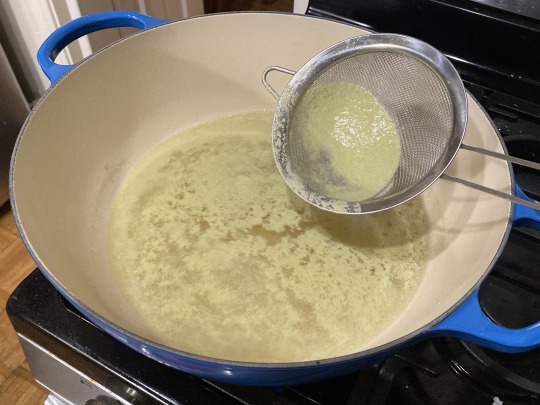
6. Eventually scum will stop rising. Continue to simmer until several shades darker in color and bubbling vigorously. Syrup should still pour freely, and just barely coat the back of a spoon. I had just over 2/3 cup (160 mL) at this point.

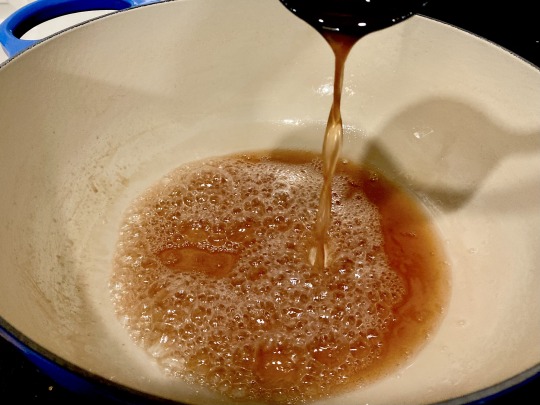
7. Remove from heat and allow to cool slightly before pouring into a jar. Allow to cool to room temperature before refrigerating. If you want to keep the syrup for multiple months or at room temperature, use a sterilized jar.
Compost the grape peels, or reserve to make fruit scrap vinegar.
For the dish:
1. Set a large bowl out several hours into a heavy snowfall; or collect just the top layer of freshly fallen snow after it has been snowing for several hours. Snow that falls earlier in a snowfall, or that has been sitting out for a longer period of time, is more likely to contain pollutants.
2. Compact the snow with a spoon to make the texture homogenous. Some people run it through a blender. Fill individual serving bowls with snow.
3. Pour cooled molasses to taste onto the snow and mix.
252 notes
·
View notes
Text
Reminder that Palestinian DNA isn't "Greek". That's some pseudo-historical BS zionists pull out of nowhere to discredit Palestinian identity.
#Palestine#Israel#Judaism#Jumblr#jewblr#jewish#arab#dna#genetics#biology#from the river to the sea palestine will be free#from the river to the sea#levant#asia#palestina#palestinian#gaza#west bank#golan heights#canaanite#levantine
10 notes
·
View notes
Text
Palestine 🇵🇸


7 notes
·
View notes
Text

2 notes
·
View notes
